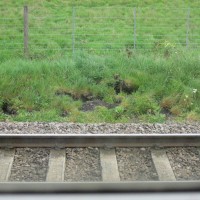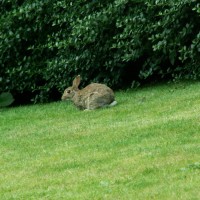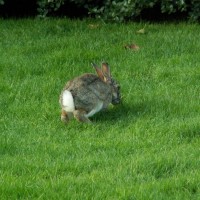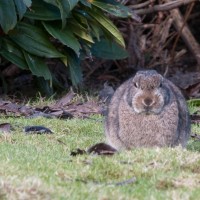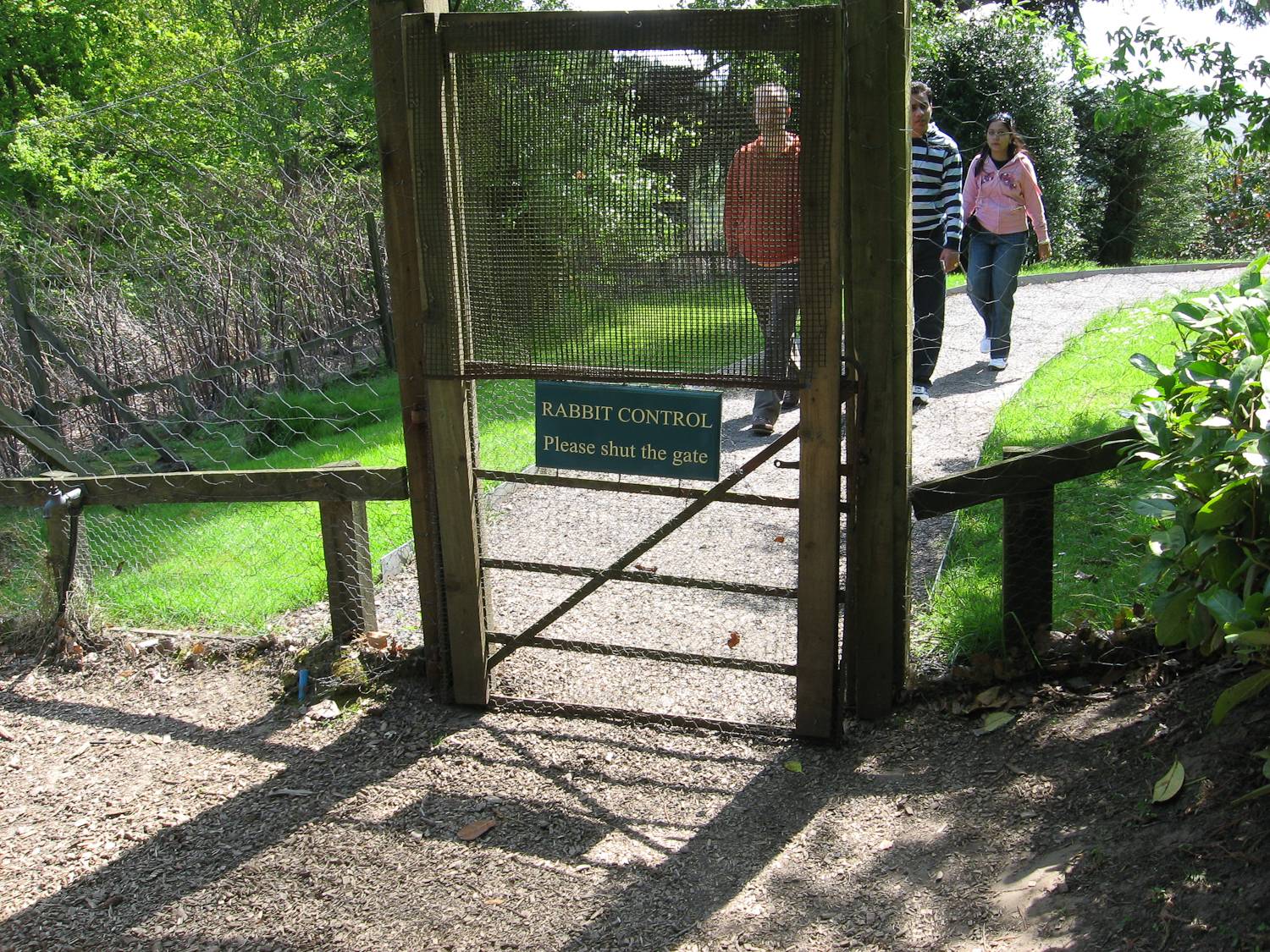
Rabbit - Oryctolagus cuniculus
Expand and collapse the sections below by clicking on the title or + / - icons.
Short description of Oryctolagus cuniculus, Rabbit
The European rabbit is a grey-brown mammal about 34–50 cm in length, with large dark eyes, long, mobile ears, large hind feet and a short, fluffy, white tail. In comparison to its relatives the brown and mountain hares, rabbits are much smaller and have shorter ears, limbs and tail and a darker iris. Dark morphs are frequent, especially in more isolated populations. Many domesticated forms have been produced and may occasionally be encountered in the wild.
Impact summary: Oryctolagus cuniculus, Rabbit
Rabbit burrowing and grazing have huge impacts on landscape and native biodiversity. They compete for food with native grazing animals, and cause widespread economic damage to grassland, crops and young trees.
Habitat summary: Oryctolagus cuniculus, Rabbit
Though some live entirely above ground, rabbits typically dig networks of burrows in sandy soils or other soft substrates, emerging to feed on grasses or cereals.
Overview table
| Environment | Terrestrial |
|---|---|
| Species status | Non-Native |
| Native range | Middle Europe, Algeria, Spain, France, Gibraltar, Morocco, Portugal |
| Functional type | Herbivore |
| Status in England | Non-Native |
| Status in Scotland | Non-Native |
| Status in Wales | Non-Native |
| Location of first record | Isles of Scilly |
| Date of first record | 1176 |
Origin
The European rabbit is native to western France, the Iberian Peninsula, Morocco and Algeria. Severe decreases have occurred throughout the native range, warranting red listing by IUCN as 'Near Threatened'. The rabbit had been introduced widely in Europe by the Middle Ages and was subsequently taken to many locations worldwide.
First Record
Rabbits were imported to GB for food by the Romans but there is no evidence of them being released into the wild until around the time of the Crusades in the 12th century, when they might have been imported by returning soldiers. An early wild population was established on the Isles of Scilly by 1176.
Pathway and Method
Rabbits were kept for food by the Romans but during the 12th century releases began onto islands, where they would act as a food resource for shipwrecked sailors, and into mainland estates where their hunting could be protected. There had been widespread escapes from enclosed mainland warrens by the mid 13th century, perhaps exacerbated by losses of farm workers during the Black Death of 1349.
Species Status
An estimated 40 million rabbits were living in Britain and Ireland in 2004. The European rabbit has been widely introduced in western and southern Europe, to all continents except Antarctica and to many oceanic islands. It is hugely invasive as a non-native species. In Australia, where a small release in 1859 had multiplied to over 600 million animals by 1950, rabbits have had disastrous effects on native mammals.
Dispersal Mechanisms
Rabbits have relatively low dispersal rates and do not generally swim. Where populations have grown rapidly, however, as in parts of Europe and Australia, they have become established over very wide areas.
Reproduction
European rabbits become sexually mature at as young as 3–4 months and can breed at any season. A single pair may raise up to seven litters a year and raise 30–40 offspring in that time. Young are born in a nesting burrow dug by the female, usually in a quiet part of the warren.
Known Predators/Herbivores
In its native range, the European rabbit supports rare and local specialist predators including the Spanish imperial eagle and the Iberian lynx. In GB, rabbits are frequently taken by aerial predators such as buzzards and by foxes, cats and mustelids. Rabbits are also very widely hunted by man. Dead animals provide carrion for corvids and red kites.
Resistant Stages
None known.
Habitat Occupied in GB
The species is found on exposed islands, on agricultural land and grassland, among scrub, in parkland and in gardens, sometimes in urban areas.
European rabbits are almost ubiquitous in GB, including many small, uninhabited islets. They are absent only from montane habitats and the most urban localities.
Environmental Impact
Establishment of a warren has profound influence on landscape and biodiversity. Grazing and sapling damage promotes a short, even sward and its specialist flora and fauna, while preventing natural succession. Burrowing creates microhabitats for other small animals including birds and various invertebrates. The animals themselves feed predators and scavengers.
Health and Social Impact
Rabbits have considerable cultural significance to people in GB both as pets but also as food. Their burrowing and grazing despoil gardens, historical sites and public amenity grassland. Burrows and droppings may be hazards to health and safety in areas well used by the public.
Economic Impact
The pest status of rabbits on farmland has been recognised in GB since the 13th century. The rabbit is the major vertebrate pest of British agriculture, causing economic losses estimated to be in excess of £250 million annually. Indeed rabbits are considered to be the most costly non-native species in GB but worldwide, and particularly on oceanic islands, they are considered to be highly invasive. Losses affect grassland, cereals, brassicas, root and market-garden crops and young trees. Burrowing causes important damage to structures such as fences and flood defences.
Identification
Macdonald, D. & Barrett, P. (1993) Mammals of Britain & Europe. HarperCollins, London.
Biology, ecology, spread, vectors
Bell, D.J. & Webb, N.J. (1991) Effects of climate on reproduction in the European wild rabbit. Journal of Zoology, 224, 639–648.
Mitchell-Jones, A.J., Amori, G., Bogdanowicz, W., Kryštufek, B., Reijnders, P.J.H., Spitzenberger, F., Stubbe, M., Thissen, J.B.M., Vohralík, V. & Zima, J. (1999) The Atlas of European Mammals. T. & A.D. Poyser, London.
Ward, D. (2005) Reversing rabbit decline: one of the biggest challenges for nature conservation in Spain and Portugal. full text
Management and impact
Angulo, E. & Cooke, B. (2002) First synthesize new viruses then regulate their release? The case of the wild rabbit. Molecular Ecology, 11, 2703–2709.
Cowan, D.P. (1984) The use of ferrets (Mustela furo) in the study and management of the European wild rabbit (Oryctolagus cuniculus). Journal of Zoology, London, 204, 570–574.
Natural England (2011) Rabbits: management options for preventing damage. Natural England Technical Information Note TIN003. full text
General
Harris, S. & Yalden, D.W. (2008) Mammals of the British Isles: Handbook. Fourth edition. The Mammal Society, Southampton.
Lever, C. (2009) The Naturalized Animals of Britain and Ireland. New Holland Publishers, London.
Smith, A.T. & Boyer, A.F. (2008) Oryctolagus cuniculus. In IUCN Red List of Threatened Species. Version 2011.1. <www.iucnredlist.org>. Downloaded on 09 August 2011. full text
Thompson, H.V. & King, C.M. (1994) The European Rabbit: the history and biology of a successful colonizer. Oxford University Press, Oxford.
Spotted this species?
Distribution map
View the Distribution map for Rabbit, Oryctolagus cuniculus from NBN Atlas









